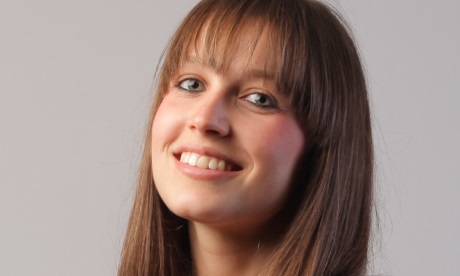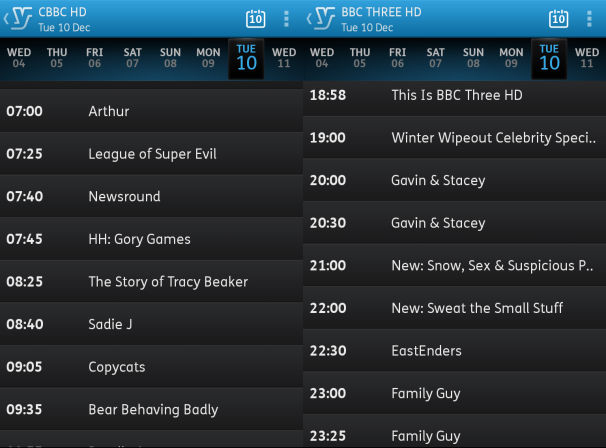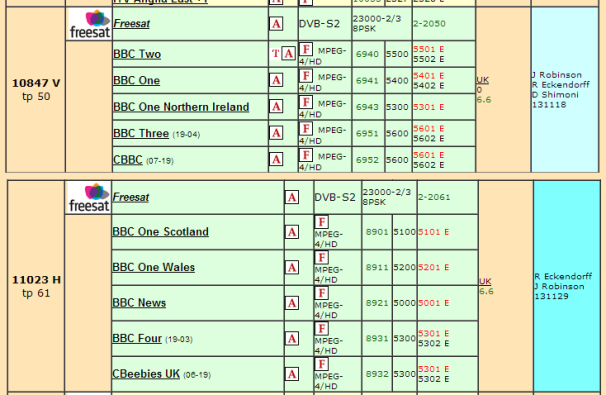On the tenth day of Christmas Auntie brought to me ... five more HD channels

It would seem the BBC are going to have five HD channels for many UK homes in plenty of time for Christmas.
Here is the evidence. First, YouView is listing the channels from 7am/7pm on 10 December 2013.

And if you look into space, you can see the channels lined on satellite too.

Remember that for Freeview HD viewers, you need to use the Crystal Palace (London), Belmont (Lincolnshire), Black Hill (Central Scotland), Emley Moor (West and South Yorkshire) and Winter Hill (Greater Manchester) transmitters to get BBC FOUR HD, CBeebies HD and BBC News HD.
UPDATE 9/12/13
The channel numbers are:

Sky HD subscribers will get the HD channels on the "usual" channel numbers: CBBCHD on 613 , CBeebies HD on 614 , BBC Three HD on 115 and BBC Four HD 116. (Virgin will get CBBCHD on 710, CBeebies HD on 711, BBC Three HD on 163, BBC Four HD 164 and BBC News HD 604).
See BBC - Blogs - About the BBC - CBBC HD, CBeebies HD, BBC Three HD, BBC Four HD & BBC News HD launch Tuesday 10 December 2013 for more.
| Whenever i watch moving sport especially football I experience much poorer pictu | 1 |
11:51 PM
Bristol
MikeB refers to the distance that one should sit from one's TV to get the best picture. How far away should I sit from my Panasonic HD-ready 32" TV? I have a YouView box, so I get HD channels.
| link to this comment |
Charles's: mapC's Freeview map terrainC's terrain plot wavesC's frequency data C's Freeview Detailed Coverage
Briantist: regarding your answer to my last question - I see from your article they were proposing COM7, COM8 and COM9, with COM9 as a SFN on C36 nationwide.
On those grounds, couldn't they have put COM8 as a C36 SFN and COM7 on whatever other vacant frequency C31 to C37 was available from the 80 sites that broadcast DTT from the outset? That would have included Stockland Hill, Preseli, Kilvey Hilll, Salisbury etc.
As for the cost of funding this - I thought they were just re-using transmitting equipment they originally used for the pre-switchover low power DTT. From 1998 to 2008 there were 80 sites, broadcasting 6 pre-DSO muxes each, i.e. 480 transmitting units located at 80 sites (Mendip, Stockland Hill, Rowridge, Salisbury etc), 6 per site. Is it true that, at DSO, all those sites had all 6 transmitting units replaced? If so, why? By reusing just TWO of those redundant units at the same 80 sites, that would have been just 160 units used, leaving 320 transmitting units still unused.
| link to this comment |
Nicholas Willmott: "On those grounds, couldn't they have put COM8 as a C36 SFN "
The national SFN was allocated as a "final" multiplex because the frequency won't be cleared by other countries until later.
"and COM7 on whatever other vacant frequency C31 to C37 was available from the 80 sites that broadcast DTT from the outset?"
No. If you look at
More Freeview capacity - COM7, COM8 and COM9 - in the 600MHz band | Freeview news | ukfree.tv - 11 years of independent, free digital TV advice you can see the hexagons and pentagons. The "old" plan uses five frequencies per multiplex, this plan uses three.
"As for the cost of funding this - I thought they were just re-using transmitting equipment they originally used for the pre-switchover low power DTT."
That's just wrong. Every site had the old equipment replaced at DSO. The new equipment was fitted in place of the analogue services and transmitter analogue until - at switchover - digital took over transmissions.
The pre-DSO equipment was a short-term low-power provision.
Com7 and Com8 are new provisions.
| link to this comment |
10:26 AM
Charles Stuart: If a customer comes in, I'll ask them the size of their current TV, its age (that will tell me its physical size), and the distance from where they sit (this gets complicated when people are different distances).
If your looking at a modern flat screen, then about 1.5m (5-6ft) is where I'd recommend. Its based on manufacturers recommendations, plus my own experience. Obviously HD is better than SD, but thats a reasonable distance.
However, if you bought a TV 5-6 years ago, that 32in TV is about 31in wide, perhaps more. Lots of people bought TV's of that size, but are actually further away, and are now finding the TV a little small (about 20 people said the same thing when I worked this weekend). For a 39-42in screen, I'd say 2.5 to 3 times the size of the screen (yes you can go closer, but my customers do not want too large a TV, so 3 is my normal distance). If you are 10 feet away (40 x 3 = 120in = 10 feet), then 39-42in is perfect, although often people will want a larger screen sometimes later on, as they get used to it.
Remember that the thick frames of 4 years ago have largely gone on main brand TV's. A Samsung 40in TV is now only about 36 inches wide, and is about 10cm wider than a 32in flat screen (a customer got his wife to measure their 32in while he was in the shop it was 800mm, then Samsung was just 902mm). Distance always equals size. Of course if your watching Blu-ray, you can sit closer still, and apparently 3D is even even better, but 2.5 to 3 is still fine.
If your too close, it will look awful, too far and you wont see anything. A customer came in yesterday to buy a lovely Sony W805 42. I'd seen her the day before, and suggested she measure before buying (we are nice that way!), but tought 40-42 would be perfect based on the information she'd given me. She did exactly that, actually took a tape measue into a rival store (they had a simlar set and the clear 10ft to measure), and concluded that the size would be perfect. Thats exactly right for her room at present, and hopefully will come back to tell me thats its fine - I'll certainly ask.
4K has 8 million tiny pixels, and it means a much finer picture, and so you can sit much much closer. However, it really need to be 4K content, because otherwise, as Mike P pointed out, the TV is using interpolation to fill in 3 out of every 4 pixels.
Ultimately, you can sit where you like, but I liken it to going to the cinema/play - nobody sits right at the front of the cinema, and you try to avoid the very back for a play. The middle is just right!
| link to this comment |
10:41 AM
Doncaster
Of course the minute the big TV set makers see a drop in the sales of their super HD sets they will roll out their next new toy for the gullable and must have. I have hd set but still prefer my old set. Super HD what next??
| link to this comment |
John's: mapJ's Freeview map terrainJ's terrain plot wavesJ's frequency data J's Freeview Detailed Coverage
11:27 AM
Bristol
MikeB. My TV was bought in early 2008. It has an annoying fault at switch on, in that sometimes it won't switch on and the green "ignition" light turns red. I have been told that it can be repaired but I might save for a new TV. What should I expect to pay for a new TV now, either 32" or 37"?
| link to this comment |
Charles's: mapC's Freeview map terrainC's terrain plot wavesC's frequency data C's Freeview Detailed Coverage
11:30 AM
Highbridge
I receive my freeview from the Mendip transmitter - does this mean I won't the new services tomorrow - Mendip is on the list, but the one you give above
| link to this comment |
Riv-dogg's: mapR's Freeview map terrainR's terrain plot wavesR's frequency data R's Freeview Detailed Coverage
11:35 AM
John Martin: Apparently Ultra Ultra HD...(8K). The format is already used on high end plantarium projectors and apparently is being used for at least one IMAX style presentation. The Japanese are planning to film some of the 2020 Games in that format Forget Ultra HD: 8K is closer than you think - Hardware
Technology has always moved forward, and generally in the face of 'its good enough'. Given the choice, would you watch a film in monochrome or colour, or one silent or with sound? Audiences have voted with their feet over the last century, and prefer what we have now (although I very much enjoy black and white films, and many silents are quite wonderful).
The pattern over the last two hundred years is that Economies of scale rapidly bring down prices and improve technology. The first VCR's cost thousands, but ended up costing less than £20. If people like and use the format, it will survive, and perhaps become universal, but thats up to the market. There are plenty of technologies which have failed, or have not been a game changer. I have no idea what 4K (or OLED) will do in the marketplace, but it will be interesting to see.
Remember that your old CRT is great for SD transmissions - thats what its was designed for. However, SD will do less well on an HD set - but HD will look far better than SD, even on a CRT. Again, its the right format for the right technology.
There is no great secret plan to get people to buy things they do not want, but in five years, why would you want to watch something in SD when you could watch it in HD?
| link to this comment |
Riv-dogg: That is correct. Mendip's COM7 doesn't come on air until some time in 2014; no date is given by Digital UK.
You may, however, be able to receive Wenvoe's, to some degree, until Mendip's comes on air. Do a manual scan of UHF channel 31 from tomorrow for Wenvoe's.
| link to this comment |
